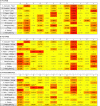Quantifying the impact of health IT implementations on clinical workflow: a new methodological perspective
- PMID: 20595314
- PMCID: PMC2995654
- DOI: 10.1136/jamia.2010.004440
Quantifying the impact of health IT implementations on clinical workflow: a new methodological perspective
Erratum in
- J Am Med Inform Assoc. 2010 Sep-Oct;17(5):612
Abstract
Health IT implementations often introduce radical changes to clinical work processes and workflow. Prior research investigating this effect has shown conflicting results. Recent time and motion studies have consistently found that this impact is negligible; whereas qualitative studies have repeatedly revealed negative end-user perceptions suggesting decreased efficiency and disrupted workflow. We speculate that this discrepancy may be due in part to the design of the time and motion studies, which is focused on measuring clinicians' 'time expenditures' among different clinical activities rather than inspecting clinical 'workflow' from the true 'flow of the work' perspective. In this paper, we present a set of new analytical methods consisting of workflow fragmentation assessments, pattern recognition, and data visualization, which are accordingly designed to uncover hidden regularities embedded in the flow of the work. Through an empirical study, we demonstrate the potential value of these new methods in enriching workflow analysis in clinical settings.
Figures




Similar articles
-
Detecting workflow changes after a CPOE implementation: a sequential pattern analysis approach.AMIA Annu Symp Proc. 2008 Nov 6:963. AMIA Annu Symp Proc. 2008. PMID: 18999105
-
Impact of ambulatory computerized physician order entry on clinicians' time.AMIA Annu Symp Proc. 2008 Nov 6:1158. AMIA Annu Symp Proc. 2008. PMID: 18998979
-
Using the time and motion method to study clinical work processes and workflow: methodological inconsistencies and a call for standardized research.J Am Med Inform Assoc. 2011 Sep-Oct;18(5):704-10. doi: 10.1136/amiajnl-2011-000083. Epub 2011 Apr 27. J Am Med Inform Assoc. 2011. PMID: 21527407 Free PMC article.
-
Computerized physician order entry in the critical care environment: a review of current literature.J Intensive Care Med. 2011 May-Jun;26(3):165-71. doi: 10.1177/0885066610387984. Epub 2011 Jan 21. J Intensive Care Med. 2011. PMID: 21257633 Review.
-
The impact of computerized provider order entry systems on inpatient clinical workflow: a literature review.J Am Med Inform Assoc. 2009 Jul-Aug;16(4):539-49. doi: 10.1197/jamia.M2419. Epub 2009 Apr 23. J Am Med Inform Assoc. 2009. PMID: 19390113 Free PMC article. Review.
Cited by
-
Development of a primary care physician task list to evaluate clinic visit workflow.BMJ Qual Saf. 2012 Jan;21(1):47-53. doi: 10.1136/bmjqs-2011-000067. Epub 2011 Sep 6. BMJ Qual Saf. 2012. PMID: 21896667 Free PMC article.
-
Measurement of clinical documentation burden among physicians and nurses using electronic health records: a scoping review.J Am Med Inform Assoc. 2021 Apr 23;28(5):998-1008. doi: 10.1093/jamia/ocaa325. J Am Med Inform Assoc. 2021. PMID: 33434273 Free PMC article.
-
Physician Workflow in Two Distinctive Emergency Departments: An Observational Study.Appl Clin Inform. 2021 Jan;12(1):141-152. doi: 10.1055/s-0040-1722615. Epub 2021 Mar 3. Appl Clin Inform. 2021. PMID: 33657633 Free PMC article.
-
Time-motion examination of electronic health record utilization and clinician workflows indicate frequent task switching and documentation burden.AMIA Annu Symp Proc. 2021 Jan 25;2020:886-895. eCollection 2020. AMIA Annu Symp Proc. 2021. PMID: 33936464 Free PMC article.
-
Natural Language Processing-Enabled and Conventional Data Capture Methods for Input to Electronic Health Records: A Comparative Usability Study.JMIR Med Inform. 2016 Oct 28;4(4):e35. doi: 10.2196/medinform.5544. JMIR Med Inform. 2016. PMID: 27793791 Free PMC article.
References
-
- National Research Council Computational technology for effective health care: immediate steps and strategic directions. Washington, DC: National Academies Press; 2009 - PubMed

